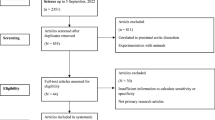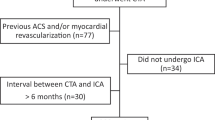Abstract
Epiaortic ultrasonography has high sensitivity for the detection of atherosclerosis. In several studies, the technique has identified atherosclerosis of the ascending aorta as the major risk factor for stroke after cardiac surgery. The level of risk depends on the presence, location and extent of disease when the ascending aorta is surgically manipulated. This knowledge enables clinicians to focus on the diagnostic and surgical technique and to consider the various options. Routine use of intraoperative epiaortic ultrasonography should be applied so that surgical manipulation of the ascending aorta can be reduced or, if possible, avoided in patients with atherosclerosis of the ascending aorta. Alternatively, if major manipulation such as clamping must be performed in the presence of severe atherosclerosis, the use of intra-aortic filters could be considered.
This is a preview of subscription content, access via your institution
Access options
Subscribe to this journal
Receive 12 print issues and online access
$209.00 per year
only $17.42 per issue
Buy this article
- Purchase on Springer Link
- Instant access to full article PDF
Prices may be subject to local taxes which are calculated during checkout
Similar content being viewed by others
References
Roach GW et al. (1996) Adverse cerebral outcomes after coronary bypass surgery. Multicenter Study of Perioperative Ischemia Research Group and the Ischemia Research and Education Foundation Investigators. N Engl J Med 335: 1857–1863
Salazar JD et al. (2001) Stroke after cardiac surgery: short- and long-term outcomes. Ann Thorac Surg 72: 1195–1202
van der Linden J et al. (2001) Postoperative stroke in cardiac surgery is related to the location and extent of atherosclerotic disease in the ascending aorta. J Am Coll Cardiol 38: 131–135
John R et al. (2000) Multicenter review of preoperative risk factors for stroke after coronary artery bypass grafting. Ann Thorac Surg 69: 30–36
Rao V et al. (1995) Risk factors for stroke following coronary bypass surgery. J Card Surg 10 (Suppl): 468–474
Newman MF et al. (1996) Multicenter preoperative stroke risk index for patients undergoing coronary artery bypass graft surgery. Multicenter Study of Perioperative Ischemia (McSPI) Research Group. Circulation 94 (Suppl II): 74–80
Ridderstolpe L et al. (2002) Risk factor analysis of early and delayed cerebral complications after cardiac surgery. J Cardiothorac Vasc Anesth 16: 278–285
Blauth CI et al. (1992) Atheroembolism from the ascending aorta. An emerging problem in cardiac surgery. J Thorac Cardiovasc Surg 103: 1104–1112
Davila-Roman VG et al. (1994) Atherosclerosis of the ascending aorta. Prevalence and role as an independent predictor of cerebrovascular events in cardiac patients. Stroke 25: 2010–2016
Hogue CW Jr et al. (1999) Risk factors for early or delayed stroke after cardiac surgery. Circulation 100: 642–647
Marschall K et al. (1994) Superiority of transesophageal echocardiography in detecting aortic arch atheromatous disease: identification of patients at increased risk of stroke during cardiac surgery. J Cardiothorac Vasc Anesth 8: 5–13
Konstadt SN et al. (1994) The ascending aorta: how much does transesophageal echocardiography see? Anesth Analg 78: 240–244
Marshall WG Jr et al. (1989) Intraoperative ultrasonic imaging of the ascending aorta. Ann Thorac Surg 48: 339–344
Davila-Roman VG et al. (1996) Intraoperative transesophageal echocardiography and epiaortic ultrasound for assessment of atherosclerosis of the thoracic aorta. J Am Coll Cardiol 28: 942–947
Amarenco P et al. (1994) Atherosclerotic disease of the aortic arch and the risk of ischemic stroke. N Engl J Med 331: 1474–1479
Sylivris S et al. (1997) The intraoperative assessment of ascending aortic atheroma: epiaortic imaging is superior to both transesophageal echocardiography and direct palpation. J Cardiothorac Vasc Anesth 11: 704–707
Hangler HB et al. (2003) Modification of surgical technique for ascending aortic atherosclerosis: impact on stroke reduction in coronary artery bypass grafting. J Thorac Cardiovasc Surg 126: 391–400
Lev-Ran O et al. (2005) No-touch aorta off-pump coronary surgery: the effect on stroke. J Thorac Cardiovasc Surg 129: 307–313
Davila-Roman VG et al. (1999) Atherosclerosis of the ascending aorta is an independent predictor of long-term neurologic events and mortality. J Am Coll Cardiol 33: 1308–1316
Konstadt SN et al. (1995) Transesophageal echocardiography can be used to screen for ascending aortic atherosclerosis. Anesth Analg 81: 225–228
Ura M et al. (2000) Ultrasonographic demonstration of manipulation-related aortic injuries after cardiac surgery. J Am Coll Cardiol 35: 1303–1310
Bolotin G et al. (2005) Use of intraoperative epiaortic ultrasonography to delineate aortic atheroma. Chest 127: 60–65
Site∼Rite Ultrasound Systems. [http://www.dymax-usa.com/products.html] (accessed 21 March 2005)
Laas J et al. (1999) Orientation of tilting disc and bileaflet aortic valve substitutes for optimal hemodynamics. Ann Thorac Surg 68: 1096–1099
Bergman P et al. (2004) Preoperative computed tomography or intraoperative epiaortic ultrasound for the diagnosis of atherosclerosis of the ascending aorta? Heart Surg Forum 7: 245–249
Summers RM et al. (1998) Evaluation of the aortic root by MRI: insights from patients with homozygous familial hypercholesterolemia. Circulation 98: 509–518
Wimmer-Greinecker G (2003) Reduction of neurologic complications by intra-aortic filtration in patients undergoing combined intracardiac and CABG procedures. Eur J Cardiothorac Surg 23: 159–164
Reichenspurner H et al. (2000) Particulate emboli capture by an intra-aortic filter device during cardiac surgery. J Thorac Cardiovasc Surg 119: 233–241
Banbury MK et al. (2003) Emboli capture using the Embol-X intraaortic filter in cardiac surgery: a multicentered randomized trial of 1,289 patients. Ann Thorac Surg 76: 508–515
Schmitz C et al. (2003) Can particulate extraction from the ascending aorta reduce neurologic injury in cardiac surgery? J Thorac Cardiovasc Surg 126: 1829–1838
Bergman P et al. (2002) Aortic atheroma is related to number of particulates captured by intra-aortic filtration in CABG. Eur J Cardiothorac Surg 22: 539–544
Sharony R et al. (2004) Propensity case-matched analysis of off-pump coronary artery bypass grafting in patients with atheromatous aortic disease. J Thorac Cardiovasc Surg 127: 406–413
Stamou SC et al. (2002) Stroke after conventional versus minimally invasive coronary artery bypass. Ann Thorac Surg 74: 394–399
Meharwal ZS et al. (2002) Off-pump multivessel coronary artery surgery in high-risk patients. Ann Thorac Surg 74: S1353–1357
Sabik JF et al. (2002) Does off-pump coronary surgery reduce morbidity and mortality? J Thorac Cardiovasc Surg 124: 698–707
Ascione R et al. (2002) Predictors of stroke in the modern era of coronary artery bypass grafting: a case control study. Ann Thorac Surg 74: 474–480
Hoff SJ et al. (2002) Coronary artery bypass in patients 80 years and over: is off-pump the operation of choice? Ann Thorac Surg 74: S1340–1343
Demaria RG et al. (2002) Reduced mortality and strokes with off-pump coronary artery bypass grafting surgery in octogenarians. Circulation 106 (Suppl I): 5–10
Khan NE et al. (2004) A randomized comparison of off-pump and on-pump multivessel coronary-artery bypass surgery. N Engl J Med 350: 21–28
Legare JF et al. (2004) Coronary bypass surgery performed off pump does not result in lower in-hospital morbidity than coronary artery bypass grafting performed on pump. Circulation 109: 887–892
Calafiore AM et al. (2002) Impact of aortic manipulation on incidence of cerebrovascular accidents after surgical myocardial revascularization. Ann Thorac Surg 73: 1387–1393
Grega MA et al. (2003) Impact of single clamp versus double clamp technique on neurologic outcome. Ann Thorac Surg 75: 1387–1391
Katariya K et al. (2004) Initial experience with sutureless proximal anastomoses performed with a mechanical connector leading to clampless off-pump coronary artery bypass surgery. Ann Thorac Surg 77: 563–568
Bonatti J et al. (2000) The subclavian and axillary arteries as inflow vessels for coronary artery bypass grafts—combined experience from three cardiac surgery centers. Heart Surg Forum 3: 307–311
Kim KB et al. (2002) Off-pump coronary artery bypass with complete avoidance of aortic manipulation. Ann Thorac Surg 74: S1377–1382
Royse AG et al. (2000) Reduced neuropsychological dysfunction using epiaortic echocardiography and the exclusive Y graft. Ann Thorac Surg 69: 1431–1438
Kapetanakis EI et al. (2004) The impact of aortic manipulation on neurologic outcomes after coronary artery bypass surgery: a risk-adjusted study. Ann Thorac Surg 78: 1564–1571
Bergman P et al. (2004) A policy to reduce stroke in patients with extensive atherosclerosis of the ascending aorta undergoing coronary surgery. Interact Cardiovasc Thorac Surg 38: 28–32
Kouchoukos NT et al. (1994) Management of the severely atherosclerotic aorta during cardiac operations. J Card Surg 9: 490–494
Gillinov AM et al. (2000) The atherosclerotic aorta at aortic valve replacement: surgical strategies and results. J Thorac Cardiovasc Surg 120: 957–963
Borger MA et al. (1999) Decreased cerebral emboli during distal aortic arch cannulation: a randomized clinical trial. J Thorac Cardiovasc Surg 118: 740–745
Hammon JW Jr et al. (1997) Risk factors and solutions for the development of neurobehavioral changes after coronary artery bypass grafting. Ann Thorac Surg 63: 1613–1618
Goto T et al. (2000) Craniocervical and aortic atherosclerosis as neurologic risk factors in coronary surgery. Ann Thorac Surg 69: 834–840
Hogue CW Jr et al. (1999) Neurological complications of cardiac surgery: the need for new paradigms in prevention and treatment. Semin Thorac Cardiovasc Surg 11: 105–115
Barbut D et al. (1997) Aortic atheroma is related to outcome but not numbers of emboli during coronary bypass. Ann Thorac Surg 64: 454–459
Calafiore AM et al. (2001) Early clinical experience with a new sutureless anastomotic device for proximal anastomosis of the saphenous vein to the aorta. J Thorac Cardiovasc Surg 121: 854–858
Author information
Authors and Affiliations
Corresponding author
Ethics declarations
Competing interests
P Bergman and J van der Linden have been members of the International Council of Emboli Management (ICEM) Study Group, which was sponsored by EMBOL-X Inc, Mountain View, CA, who manufacture intra-aortic filters
Glossary
- TYPE I NEUROLOGIC INJURY
-
Focal injury, stupor or coma at discharge from hospital
- EPIAORTIC ULTRASONOGRAPHY
-
Ultrasound scanning in which the transducer is placed directly on the aorta to assess atherosclerosis
- HARD-SHELL STANDOFF
-
Part of the probe that distances the ultrasonic transducer from the aorta to enable sharp focus of surface structures very close to the device tip
Rights and permissions
About this article
Cite this article
Bergman, P., van der Linden, J. Atherosclerosis of the ascending aorta as a major determinant of the outcome of cardiac surgery. Nat Rev Cardiol 2, 246–251 (2005). https://doi.org/10.1038/ncpcardio0192
Received:
Accepted:
Issue Date:
DOI: https://doi.org/10.1038/ncpcardio0192
This article is cited by
-
The effect of intravenous lidocaine on postoperative cognitive dysfunction: a systematic review and meta-analysis
BMC Anesthesiology (2023)
-
Predictors and clinical outcomes of post-coronary artery bypass grafting cerebrovascular strokes
The Egyptian Heart Journal (2022)
-
Atherosclerotic disease of the abdominal aorta and its branches: prognostic implications in patients with heart failure
Heart Failure Reviews (2012)
-
Neurologische Komplikationen nach herzchirurgischen Operationen
Zeitschrift für Herz-,Thorax- und Gefäßchirurgie (2011)
-
Aortokoronare Bypass- und Herzklappenoperationen
Der Internist (2007)



